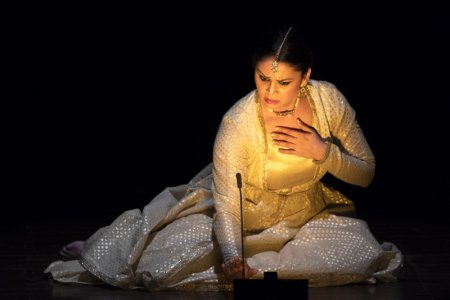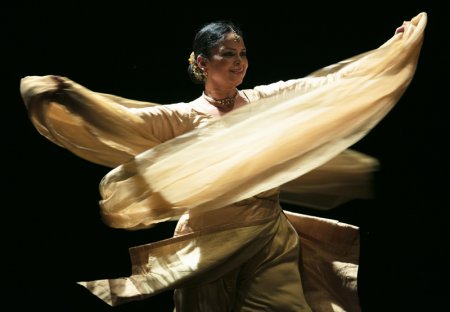
|   |

|   |
Emptiness or Ecstasy? - Madhur Gupta e-mail: madhurgupta04@gmail.com Photos: Inni Singh August 2, 2019 Emptiness is a state of ecstasy where a thousand suns glow. Different from a vacuum where nothing can exist, emptiness shows the possibility of being filled in with the cacophony of life. Emptiness is the metaphorical representation of our insignificant mortal lives in this grand scheme of universe which are ever the ephemeral and transitory; here now, gone the next. And then what remains, is the ultimate truth: emptiness.  Presenting such abstract concepts, one witnessed Kathak dancer Gauri Diwakar with Bhuvanesh Komkali giving the vocal rendition for their collaborative experience titled ‘Dancing Emptiness’. Now one wonders how does one dance nothingness; to this valid thought process the artistes chose to present literature from mystics like Kabir and great teachers like Gautam Buddha who dwelt their lifetimes on the meditative aspect of nothingness. Created for the Sandhi series in the Serendipity Arts Festival curated by Sanjeev Bhargava (Director of Seher Foundation), Gauri shared; “I was eager to explore the mystical and transient poetry of Kabir. When the opportunity came, I approached my Guru Aditi Mangaldas to choreograph it for me as I still am in the process of learning to create productions of international standards from her.” The production began with a resonating alaap in raga Bhimpalasi by Bhuvanesh, establishing the gravitas of the subject at hand. Dancing Emptiness, divided in parts, weaved together several metaphorical texts insinuating the fragility of life. “It is very important for me to get into the skin of the danced text and transform it for our medium. There is a saying: No great art can be interpreted by another great art, it can only be transformed”, informed Mangaldas on how she treated an abstract subject. Relying on the angika abhinaya, using symbolic props like that of a golden thread, a scarf, and even a golden white costume, the choreographer and the dancer explored the entire cycle of life, traversing in search of the truth, and the final release from the illusionary Maya of the samskaras one is held in. While the doha in raga Yaman, ‘Chal Hansa us desh jahan piya base chittachor’ explored the conceptual theme of using soul as a simile for the swan in search of the beloved, ‘Asana se mat dol tohe piya milenge’ woven in raga Sohini brought the metaphorical seeker to the ultimate truth. It can be left to the rasikas to choose whether they conceived the ‘piya’ as their mortal loved one, submerging into the immortal God, or just reaching a state of nothingness where all is present yet absent and that momentary illusion is Now. The dancer has an indelible mark of her guru in her rendition of technique. With swift pirouettes, contrasting freezes, and sharp movements, the choreographer with her disciples continues to forge an original language based on classical principles. Another sturdy stamp of rendering music, breaking free from any particular style prevalent, Bhuvanesh Komkali followed successfully the path conceived by his grandfather, the stalwart Hindustani vocalist late Pandit Kumar Gandharva. With a freshness in his approach, when Komkali sang a doha using the simile of shrutis merging into the swaras akin to the fish’s existence in water, the rasikas felt a sensory exultation as if one had found a new secret to happiness which only they individually were party to. As to how he adjusted to binding his music for a dance presentation, Bhuvanesh stated, “My father Pandit Mukul Shivputra often described classical music as bandhan purna, where improvisation or artistic exploration is always within external constraints. Yet there is freedom, despite the bindings.”  Talking about limitations of an art, one feels that the dancer could have further utilized and explored the meditative aspects of the theme without delving into literal usages of the texts and rushing the pieces into technical portions of toras, tukras, parans, paramelus of which contemporary Kathak has so deeply fallen victim to. The Delhi audience over the years has been trained in such a manner that they are on a constant look out for a sam, giving them an opportunity to show off their rhythmic sensibilities, resounding the hall with applauses, losing the solemnity of emptiness. It is ironical that when one discussed the bhava paksha with a few audience members post performance, they were all praises for the pakka riyaz and technical virtuosity but failed to at length fathom the theme at hand. And therein lies the challenge for Gauri Diwakar, a seasoned and able Kathak dancer to fill in this chasm of uplifting the entire art from the abyss of superficial intricacies and raising it back to the heights of being a meditative experience, especially when picking up such dense and abstract subject matter. Having said so, one cannot undermine the hard work which was put up by Diwakar in mounting up such a concert, evoking from connoisseurs such contrasting views. The classical arts scene absolutely needs such thought provoking works. The pieces might click for just some, but that is exactly the purpose of the arts; to elicit emotions out of those who experience it. Philosopher J. Krishnamurti has quoted, ‘Meditation is the freedom from thought, and a movement in the ecstasy of truth’, and one feels that we all need to get into a reflective mode, contemplating on the impermanence of our lives and one must give due credit to Gauri Diwakar and her Guru for time and now throwing at the otherwise placid arts scene, such thought provoking works of art. Odissi dancer Madhur Gupta is a disciple of Guru Sharon Lowen. He contributes to national dailies like The Hindu, The Times of India, The Asian Age, The Indian Express covering at large the Indian classical dance and music scene of the subcontinent. |